David Samuel (Dovid Schmuel) MARGULES was born in what was then called Lemberg, the capital of the Austrian Crown Land of Galicia, on September 21, 1884. He was the third of the six children of the Jewish couple Penina Pess and Menachem Mendel Margules. Menachem Mendel Margules was a leather dealer in Lemberg (called Lwów in Polish, Lviv in Ukrainian, and Lemberg/Lemberik/Lvov in Yiddish).
As he later recalled, much to the disappointment of his parents the young David Samuel abandoned the religious culture of the Orthodox Jews in Galicia in order to seek a realization of his ideals in the bourgeois education and high culture of the Imperial Capital Vienna.
David Samuel attended the renowned Benedictine Schotten-gymnasium before he went on to complete studies in rabbinical and philosophical studies and earn a doctorate in philosophy. After that he was a religion teacher in Vienna for a few years as he prepared to serve as a rabbi.
In 1920, after the fall of the Austro-Hungarian Monarchy and the annexation of the Galician crownland to the new Polish State, the 35 year old Dr. MARGULES married a 23 year old Jewish woman from Jaroslaw Poland named Rosa Zerline Leinwand.
The couple had two daughters: Josefa Nina who was born on May 16, 1921 in Jaroslaw and Gabriele Ella who was born on May 30, 1927 in Tachov (Tachau in German). In the 1920s their father was the rabbi for the Tachov/Tachau district near the famous Marienbad Spa (Mariánské Láznì) in Czechoslovakia.
In the 1920s the Salzburg Jewish Community Organization failed to find a replacement for its rabbi Dr. Adolf ALTMANN after he left for a much more important post in Trier – the virulent Antisemitism of Salzburg at the time was one factor in making it unattractive for new candidates.
Towards the end of the decade the Jewish Community Organization of Salzburg city and state had 108 paying members, but it was badly split between two opposed factions: religious conservatives versus Zionists. In 1929 the religious conservatives managed to win a majority in the community council and the new officers renewed the search for a rabbi – the Salzburg Zionists, led by Walter SCHWARZ (business manager of the S. L. Schwarz department store), were disadvantaged by the electoral system in use.
On September 27, 1929 Dr. MARGULES, who had applied for the vacant positon for a Salzburg rabbi, met with the community members at the synagogue to get to know each other. Afterwards he was unanimously elected to be Salzburg’s rabbi and it was said that he won the support of all the Jews in the city – a remarkable achievement given the tensions between the conservatives and the Zionists. Dr. MARGULES wasn’t a political Zionist, he was a religious Jew who kept his distance from politics.
Starting in 1930 the MARGULES lived in Salzburg’s Elizabethvorstadt neighborhood. On January 17, 1930 Dr. MARGULES gave his first sermon in der Synagogue.
In the same year he lectured about Orthodox Judaism and about Heinrich Heine and his conversion to Christianity. He also gave a memorial lecture on the anniversary of the death of Theodor Herzl as the founder of political Zionism.
The collective Hanukah festivals led by Rabbi MARGULES (until the last one in December 1937) indicated the unity he managed to establish: »the cohesion of all Jewish fellow-believers«.
Rabbi MARGULES was able to overcome the tensions between the Conservatives and the Zionists and find compromises acceptable to both sides: six Conservatives and six Zionists joined in a single list for election to the community council in May 1935 so that the Salzburg born conservative Otto Löwy (1883) – son of former president Rudolf Löwy – served as community president from 1935 to 1938 along with two older Zionists who served as vice presidents: Ludwig FISCHER (born in 1868) and Ludwig Pollak (born in 1856, he was the nephew of the founder of the Salzburg Jewish community Albert Pollak – who was the first Jew allowed to settle in Salzburg after the creation of the Austrian constitution in 1867).
Ludwig Pollak was a retired official (Oberregierungsrat) and had lived longer in Salzburg than any other Jew. His son Ernst was the first Jew born in Salzburg to travel to Palestine to start a new life, but he died there in 1920.
In the Spring of 1936 the 80 year old widower Ludwig Pollak left Salzburg to join his married daughters Margarethe and Gertrud in Trieste. Dr. Paul Schwarz, the younger brother of Walter SCHWARZ, replaced him as vice-president of the Jewish Community Organization.
At the beginning of the 1930s Dora Schwarz, Walter SCHWARZ’ wife, had moved to Palestine (Eretz Israel) with their three sons: Hugo, Rafael and Benjamin. Dora Schwarz returned to Salzburg on occasion and gave lectures while she was back, including ones on »The condition of the German Jews in Palestine« (1933) and »A Jewish woman farmer talks to you« (1935).
This was just one indication of the leading role women played in the local Zionist organization. For another example we can point to when Edith Ornstein lectured about women in Zionism in the presence of the rabbi.
Regular donations flowed from Jewish Salzburg to »Keren Kajemeth«, the Jewish National Fund which helped Jews get established in Eretz Israel. Stefan ZWEIG was among the donors even though he was not a Zionist.
On the occasion of his 50th birthday on November 28, 1931 the local Zionist organization sponsored a tree planting in Eretz Israel in the name of Stefan ZWEIG – on the initiative of his friend Walter SCHWARZ.
Thanks to a long neglected source we now know that on November 15, 1937 Dr. MARGULES fulfilled a long desired goal of the local Zionist organization: the opening of a Jewish library in the Synagogue. Sadly the titles of the books included have been lost, but the names of their donors are known.
They were all Jewish, including Stefan ZWEIG who donated 140 books by Jewish authors after he sold his Salzburg home in May 1937 – books that disappeared without a trace after the Nazis took over Austria the next year.
Salzburg’s Antisemites knew since the 1920s who was Jewish according to racist criteria. Their names and addresses appeared on the »Jew lists« published by the Salzburg League of Antisemites to promote the boycotting and expulsion of all Salzburg Jews.
From the 1920s until March 1938 the league posted its lists in »Aryan« shops and they advertised the fact in the newspapers:
Attention!
The Jew list of Salzburg is available for inspection at my shop!
Hans Mösel – Zur Küchenfee, Salzburg, Linzergasse 56
Salzburger Volksblatt, March 15, 1938, page 12
The boycott calls »Kauft nicht bei Juden!« [Don’t buy from Jews] and the proximity of the city of Salzburg to Nazi Germany made things very difficult for the Jewish community.
That is visible from the decreasing numbers of Jewish births and marriages – though this data has to be reconstructed with great effort from other official records as the birth and marriage registers of the Salzburg Jewish Community Organization were stolen by the Nazi regime and have counted as »lost« since then.
Research indicates that in the seven decades of Jewish life in Salzburg between the return of Jews in 1867 and their expulsion by the Nazis 192 children were born to Jewish couples: 154 children during the Habsburg Monarchy years and 38 in the following years.
The last birth of a Jewish child in Salzburg was registered on September 24, 1933 (!).
It was Ernst Grün, son of Ilse and Dr. Franz Grün, an attorney, Zionist and member of the Jewish Community Organization council. The Grüns recognized the danger in time and fled to Argentina in March 1938.
The Jewish community shrank rapidly. In the eight years that Dr. MARGULES was rabbi in Salzburg only two couples got married in the synagogue, both early in the decade: on March 2, 1930 Edith Eisenberg from Salzburg married Gustav Reitmann from Leoben (later they emigrated to Palestine with their daughter Marion who had been born in Salzburg); on September 17, 1933 Else Schneider from St. Johann im Pongau married Felix Preis from Klagenfurt (their children Eva and Peter were born in Klagenfurt and the whole family was murdered in Auschwitz in 1944).
Many Jews preferred to leave their birth city of Salzburg and ended up marrying abroad after having seen at an early age the rule of Chancellor Adolf Hitler just outside the city line across German border since 1933: Margarethe and Gertrud Pollak found spouses in Triest; Liselotte Bäck, Martha Eisenberg, Walter Weinstein and Hugo Schwarz in Jerusalem or Tel Aviv.
In May 1939 Tamara and Hugo Schwarz got their first son in Tel Aviv and named him after his grandfather Walter SCHWARZ who suffered a violent death on September 1, 1938 while he was a prisoner of the Gestapo in Munich.
How did Jews react to the National Socialist terror in Salzburg? The question was to flee or stick it out? In retrospect Josefa Nina Lieberman, Rabbi Dr. MARGULES’ older daughter wrote:
As a rabbi, Dr. Margules felt that jewish life had to go on, and his first contact with the newly established authorities [Gestapo] was to ask permission to hold Sabbath services for his congregation.
It just so happened that this coincided with the reading of the ancient threat to the survival of the Jewish people [the Purim holiday].
Rabbi Dr. MARGULES faced the threats and did his best – until the dissolution of his community in November 1938. Even before the »Reichskristallnacht« pogrom of November 1948 several Jewish families had to abandon their homes and leave their homeland.
Some others fled to temporary refuges with friends. Their last addresses were recorded in the »Jew lists« of the police.
The remainder faced the attacks of some 30-50 uniformed Nazi Storm Troopers in the night of November 9-10, 1938: when most of Salzburg’s Jewish men were arrested, seven Jewish shops were looted and the Synagogue was severely damaged.
A photo by press photographer Franz Krieger shows the front yard of the synagogue with a Talis (a Jewish prayer shawl) wrapped around a pile of prayer books stacked in the form of a cross so as to resemble a grave cross – symbolizing »Death to the Jews«.
Josefa Nina, the rabbi’s daughter said that her endangered family also got some sympathy, albeit in anonymous letters. Particularly painful was the silence of the Christian Churches in the face of the brutal anti-Jewish pogrom with the spectacle of cheerful onlookers who joined in the looting, the arrests of »c. 60-70 Jews« (according to the SS report), and the police raids on the homes of the victims
On the instructions of SS-Sturmbannführer Karl-Heinz Rux the Salzburg Gestapo-branch acted to speed up the expulsion and robbery of the Jewish families by deporting 26 Jewish men born between 1883 and 1914 to the Dachau concentration camp (arrivals registered on 12 November 1938), including the rabbi Dr. MARGULES and the president of the religious community Otto Löwy.
While the Rabbi was imprisoned in Dachau (prisoner number 23535) his wife and his 17 and 11 year old daughters were forced to clear out their apartment, pack their suitcases, and move to Vienna.
Their lovely apartment at 38 Josef-Mayburger-Kai was taken over by a Salzburg Nazi party functionary – district-office-manager Karl Feßmann.
The Jews mistreated in the Dachau Concentration Camp were soon released, Dr. MARGULES on December 5, 1938 and the last ones at the end of the year (but only after they signed agreements to leave the country as soon as possible).
Thanks to their contacts the MARGULES family received a permit to emigrate to England. And so the endangered family in Vienna was enabled to reach freedom and safety, the daughters in February 1939 and their parents the next month.
In England the MARGULES were stateless persons having been stripped of their German citizenship: a refugee family living in precarious and precarious conditions during the Second World War.
But they found a place to stay in Cambridge and three years after the end of the war Dr. MARGULES became a British subject.
He died in Cambridge at age 66 on February 10, 1951, wife Rosa died in 1992 at age 95.
Their daughters Josefa Nina and Gabriele Ella lived in the USA.
Josefa Nina was a psychologist and died in 2012, while the artist Gabriele Ella died in 2016. The psychologist Josefa Nina Lieberman wrote an informative and moving biography of her father: He came to Cambridge: Rabbi David Samuel Margules that was published in 1982.
Decades passed before the names and places of Salzburg’s Shoah victims found a place in the collective memory of the City of Salzburg.
But since August 2007 »Stolpersteine« [Stumbling Blocks] have become parts of the public spaces and everyday experiences in the city and the biographies of the victims have become available in both German and English worldwide via the internet.
Sources
- Salzburg city and state archives
- Israelitische Kultusgemeinde Salzburg
- Mitteilungen für die jüdische Bevölkerung der Alpenländer [Information about the Jewish population of the Alpine lands] (Upper Austria State Library)
- Josefa Nina Lieberman: He came to Cambridge. Rabbi David Samuel Margules, Cambridge 1982
Translation: Stan Nadel
Stumbling Stone
Laid 27.01.2020 at Salzburg, Josef-Mayburger-Kai 38
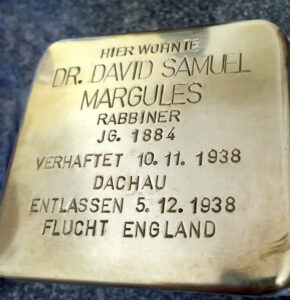
 Portrait Rabbi David Samuel Margules by Gabriele Margules
Portrait Rabbi David Samuel Margules by Gabriele MargulesSource: Leo Baeck Institute, The Edythe Griffinger Art Catalog
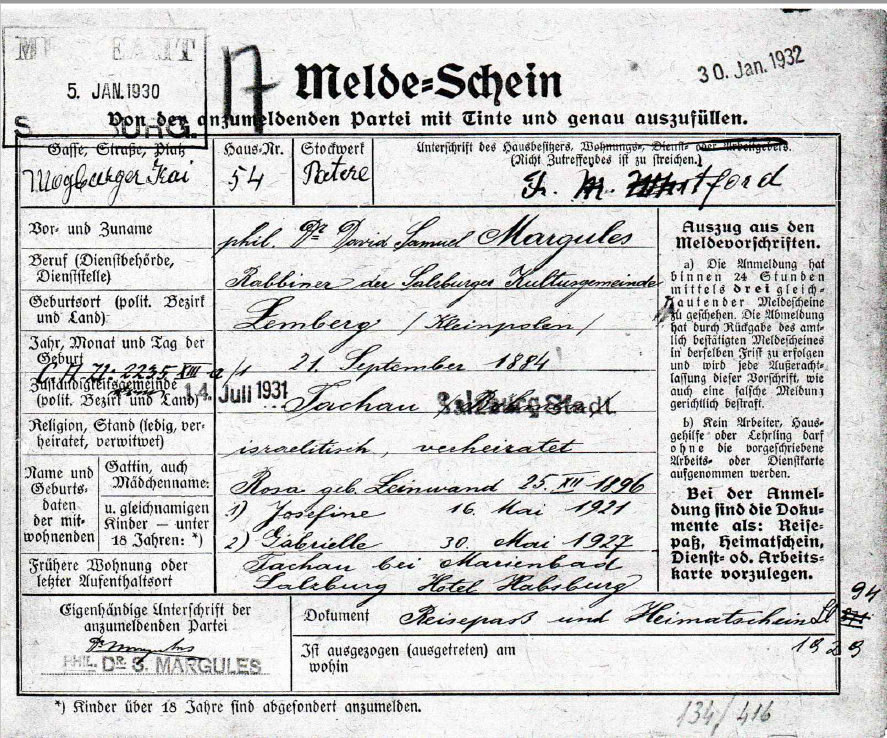 Registration Card of the Margules family (front side)
Registration Card of the Margules family (front side)
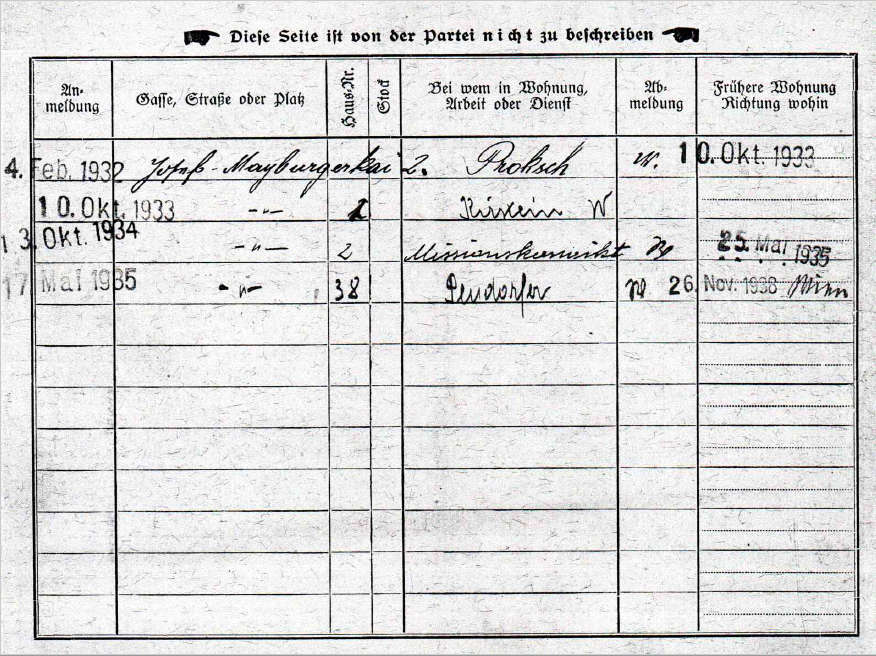 Registration Card of the Margules family (back side)
Registration Card of the Margules family (back side)
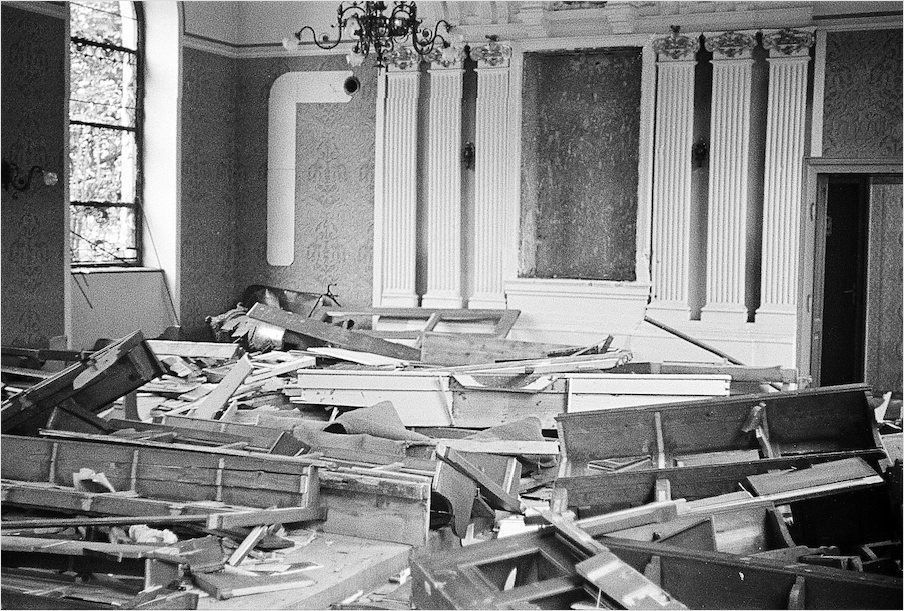 Devastated Lasserstraße Synagogue after the November-Pogrom 1938
Devastated Lasserstraße Synagogue after the November-Pogrom 1938Source: Salzburg City Archives, Franz Krieger Photo Collection
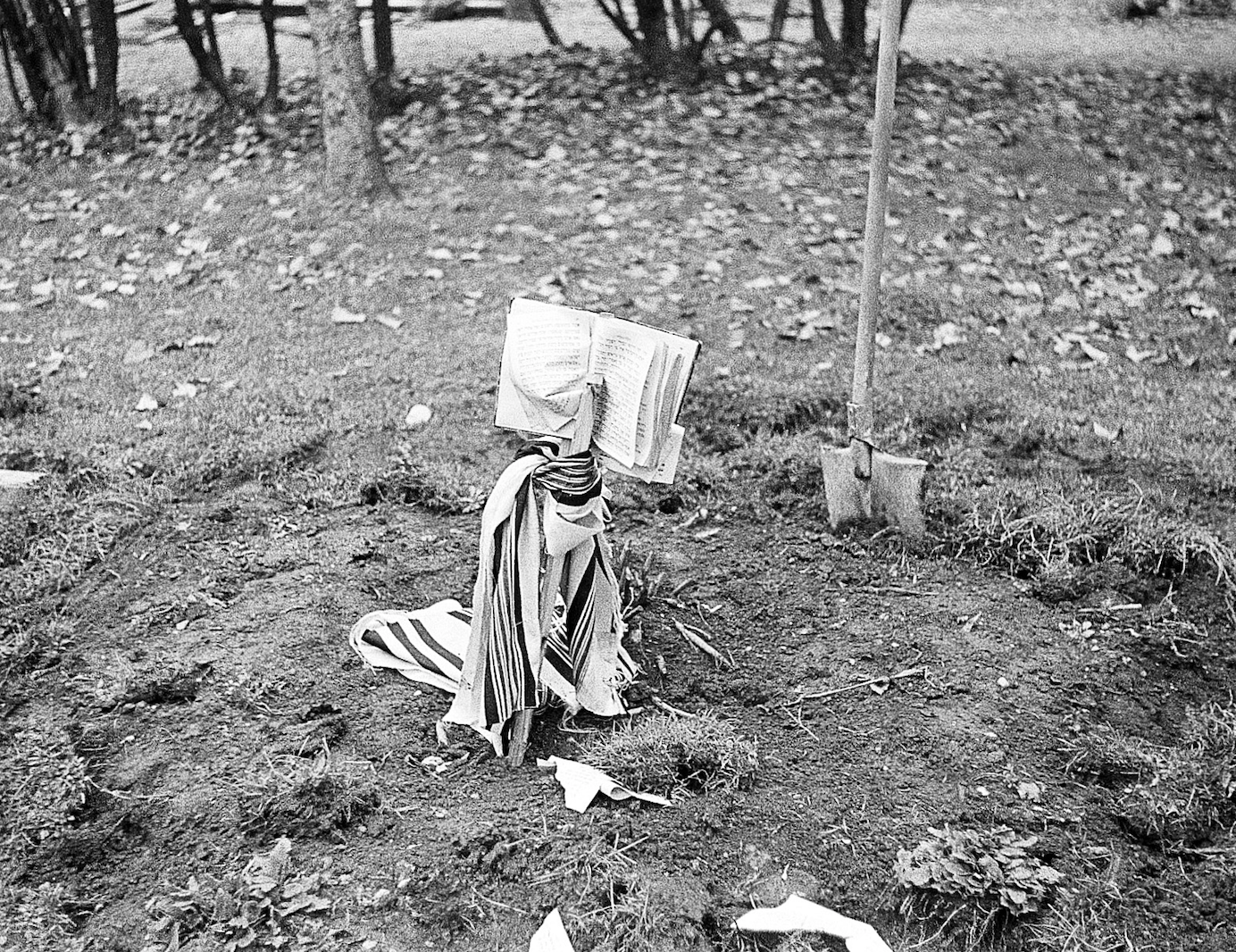 Garden of the vandalized Synagogue – Jewish religious objects as cross for a grave
Garden of the vandalized Synagogue – Jewish religious objects as cross for a graveSource: Salzburg City Archives, Franz Krieger Photo Collection
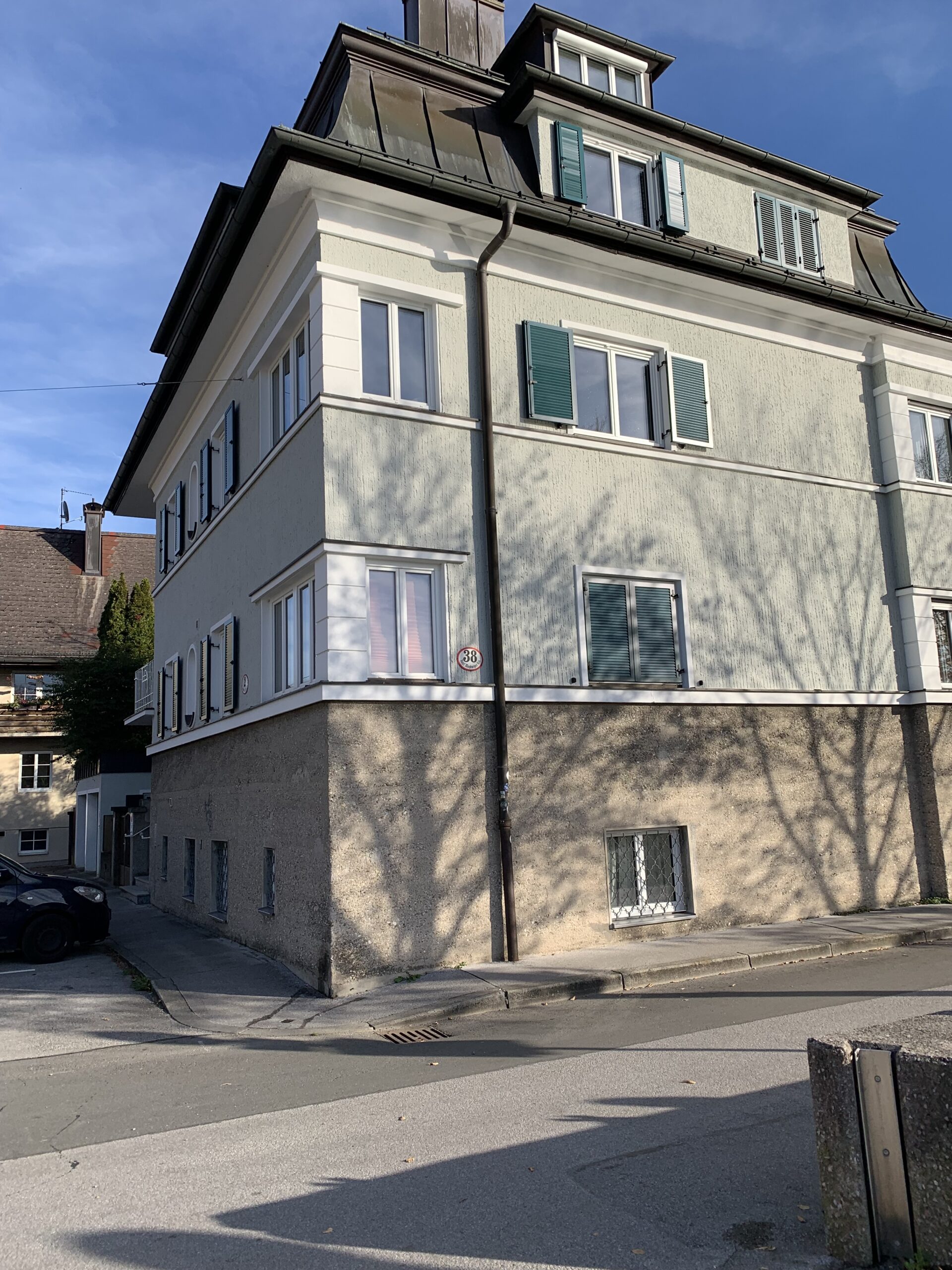 Photo: Stan Nadel
Photo: Stan Nadel
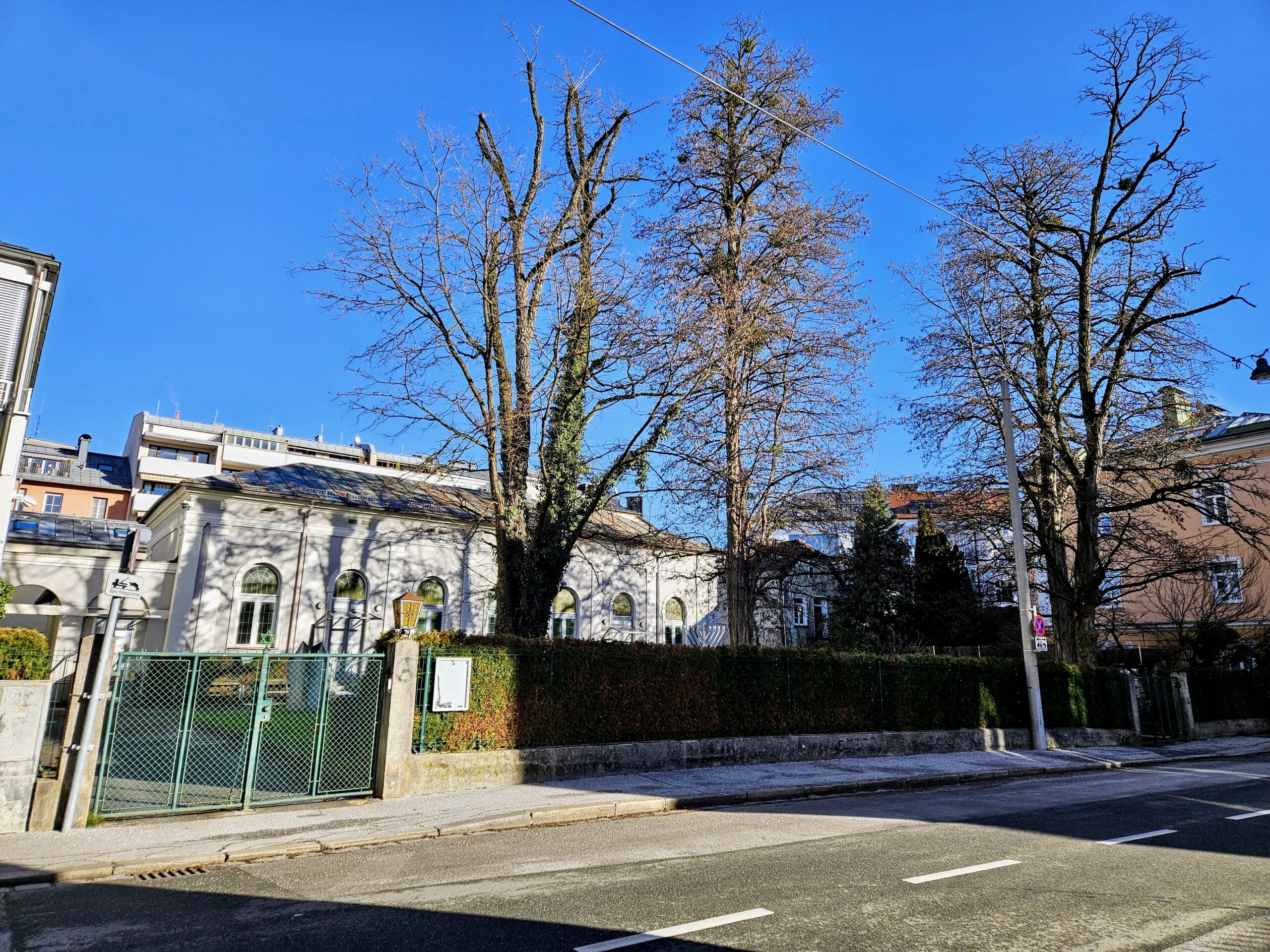 Photo: Gert Kerschbaumer
Photo: Gert Kerschbaumer
